#Norwegians Land in Iceland in 872
Text

“The Norwegians Land in Iceland Year 872”, Oscar Wergeland, 1877.
119 notes
·
View notes
Photo

Norwegians Land in Iceland in 872, by Oscar Wergeland, 1877. National Gallery of Norway
#Oscar Wergeland#Norwegians Land in Iceland in 872#1877#vikings#Norway#Egil the Mean#the arts#Egil Skallagrimsson#Iceland
12 notes
·
View notes
Photo
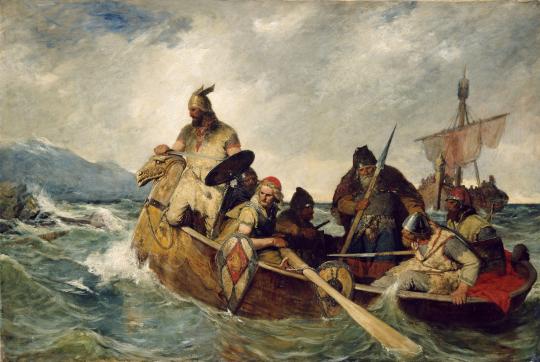
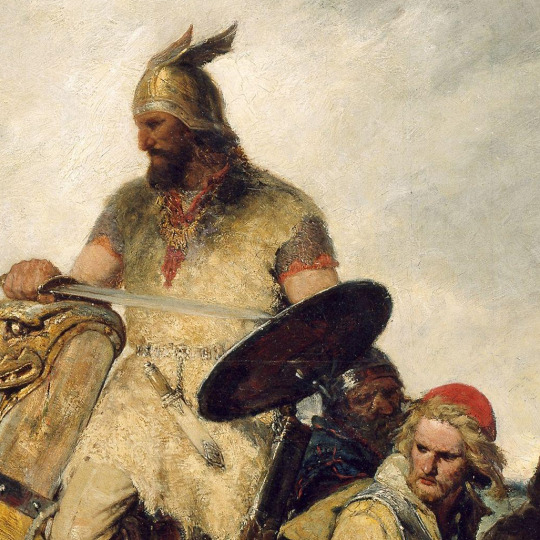

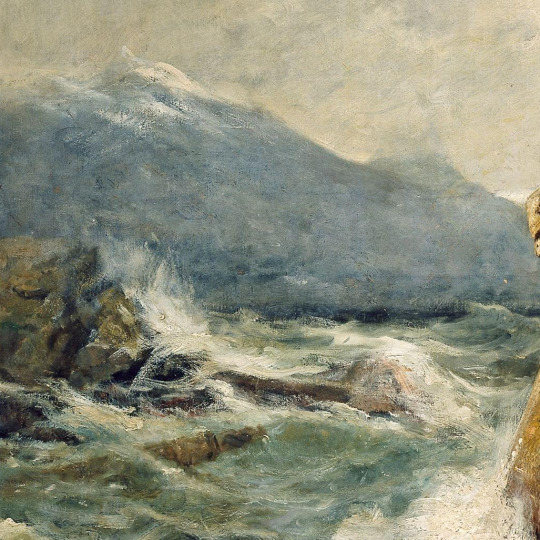
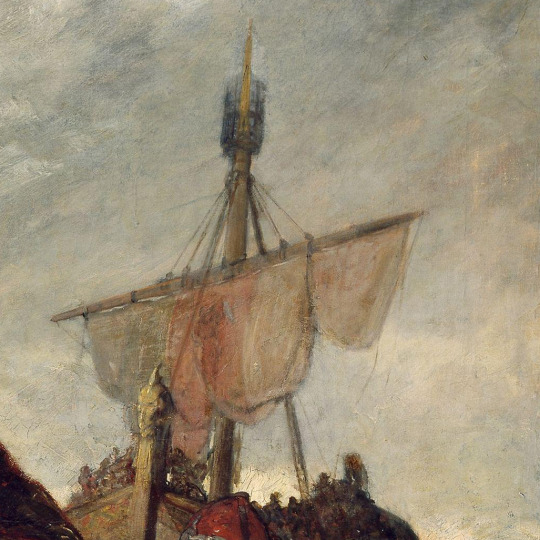
Oskar Arnold Wergeland [Norwegian, 1844-1910]
The Norwegians land in Iceland, year 872 (1877)
Oil on canvas, 175 x 117 cm
National Museum of Art, Architecture and Design, Oslo, Norway
4 notes
·
View notes
Photo
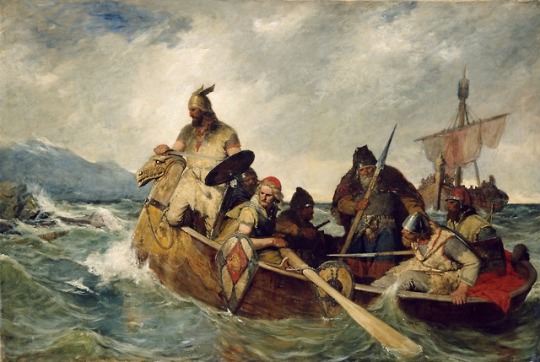
The Norwegians Land in Iceland, Year 872 (1877), by Oscar Wergeland.
The landnám (“land-taking”) in Iceland began in the year 874, when Ingólfr Arnarson founded Reykjavík with his wife and brother. He was the first person to sail to Iceland with the specific intention of settling the land, but archaeological finds suggest that others may have settled there before him.
Iceland was uninhabited except for a few Celtic monks, who had sailed there to find solitude. According to Ari Þorgilsson, they left because they did not want to live among the Norse pagans.
The landnám continued until around the year 930, with the establishment of the Alþingi, Iceland's national parliament. However, settlers continued to arrive throughout the 10th century.
Iceland's settlers were predominantly Norse, with a number of Celts (mostly women) among them. Small-scale chieftains also travelled to Iceland, where they became goðar, or priest-chieftains. Some of them, according to medieval Icelandic sources, may have left Norway because they had difficulties with the centralization of royal power.
#history#art#geography#immigration#vikings#norway#iceland#reykjavík#oscar wergeland#igólfr arnarson#hallveig fróðadóttr#jörleifr arnarson#ari þorgilsson#landnám#alþingi
33 notes
·
View notes
Text
A brief history of the Vikings
They are regularly depicted simply as one-dimensional warriors whose accomplishments incorporate minimal more than looting and assaulting. However, as Philip Parker clarifies, this was not the full degree of the Viking scene…
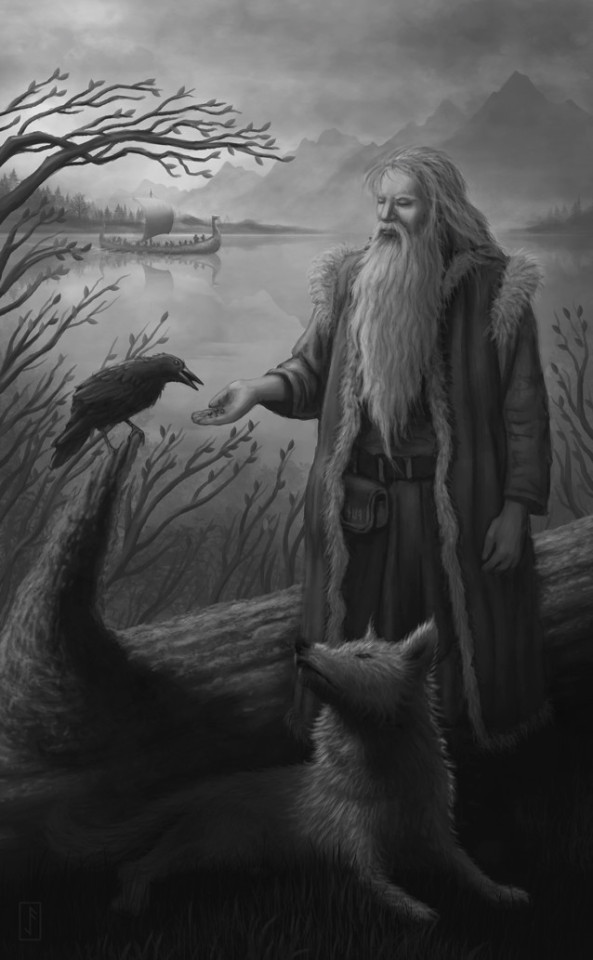
In 793, dread plummeted on the bank of Northumbria as equipped bandits assaulted the exposed cloister of St Cuthbert on Lindisfarne. The alarmed priests observed defenselessly as the intruders grabbed a pull of fortune and a grasp of prisoners. It was the principal recorded attack by the Vikings, seaborne privateers from Scandinavia who might go after beach front networks in north-western Europe for over two centuries and make for themselves a notoriety for being savage and merciless warriors.
That picture was amplified by the individuals who expounded on the Viking assaults – at the end of the day, their casualties. The Anglo-Saxon pastor Alcuin of York composed significantly of the Lindisfarne assault that the "congregation was scattered with the blood of the clerics of God, plundered of every one of its decorations… given as a prey to agnostic people groups" and resulting (for the most part Christian) scholars and writers lost couple of chances to slander the (primarily agnostic) Vikings.
However, however they irrefutably did exceptionally dangerous and vicious assaults, from little scale strikes against houses of worship to significant battles including a great many warriors, the Vikings shaped piece of a complex and regularly modern Scandinavian culture. And also plunderers they were brokers, coming to as far east as the streams of Russia and the Caspian Sea; pilgrims, sending ships far over the Atlantic to arrive on the coastline of North America five centuries previously Columbus; artists, forming refrain and exposition adventures of incredible power, and specialists, making works of bewildering excellence.
Viking starting points
The Vikings started in what is presently Denmark, Norway and Sweden (despite the fact that hundreds of years before they wound up bound together nations). Their country was overwhelmingly rustic, with no towns. By far most earned a pitiful living through agribusiness, or along the drift, by angling. Advances in delivery innovation in the seventh and eighth hundreds of years implied that water crafts were fueled by sails as opposed to exclusively by paddles. These were then added to vessels made of covering boards ('clinker-worked') to make longships, quick shallow-drafted pontoons that could explore seaside and inland waters and arrive on shorelines.
Precisely what initially constrained groups of men to take after their neighborhood chieftain over the North Sea in these longships is vague. It might have been confined overpopulation, as plots moved toward becoming subdivided to the point where families could scarcely squeeze out a living; it might have been political shakiness, as chieftains battled for strength; or it might have been news brought home by vendors of the wealth to be found in exchanging settlements advance west. Likely it was a blend of every one of the three. However, in 793 that initially assaulting party hit Lindisfarne and inside a couple of years assist Viking groups had struck Scotland (794), Ireland (795) and France (799).
Their casualties did not allude to them as Vikings. That name came later, getting to be advanced by the eleventh century and potentially getting from the word vik, which in the Old Norse dialect the Vikings talked signifies 'narrows' or 'delta'. Rather they were called Dani ('Danes') – there was no sense at the time this ought to allude just to the occupants of what we currently call Denmark – pagani ('agnostics') or basically Normanni ('Northmen').
Strikes
At first the strikes were little scale issues, a matter of a couple of boatloads of men who might return home once they had gathered adequate loot or if the opposition they experienced was excessively solid. In any case, in the 850s they started to overwinter in southern England, in Ireland and along the Seine in France, building up bases from which they started to command inland regions.
The strikes achieved a crescendo in the second 50% of the ninth century. In Ireland the Vikings built up longphorts – invigorated ports – including at Dublin, from which they commanded a great part of the eastern piece of the island. In France they developed in quality as an isolated Frankish kingdom cracked politically and in 885 a Viking armed force assaulted and nearly caught Paris.
In Scotland they set up an earldom in the Orkneys and overran the Shetlands and the Hebrides. What's more, in England a colossal Viking host, the micel here ('extraordinary armed force') touched base in 865. Driven by a couple of warrior siblings, Halfdan and Ivar the Boneless, they picked off the Anglo-Saxon kingdoms of England one by one. First Northumbria, with its capital at York, tumbled to them in 866, at that point East Anglia, trailed by the focal English kingdom of Mercia. At long last, just Wessex, managed by Alfred, remained. A devout savant, Alfred had just progressed toward becoming lord since his three more military more established siblings had sickened or kicked the bucket fighting in past Viking intrusions.
Toward the beginning of January 878 an area of the Great Army driven by Guthrum crossed the boondocks and got Alfred off guard the illustrious home at Chippenham. Alfred scarcely figured out how to escape and invested months lurking in the Somerset swamps at Athelney. It resembled the autonomy of Wessex – and that of England for the most part – may be at an end. Yet, against the chances Alfred assembled another armed force, crushed the Vikings at Edington and constrained Guthrum to acknowledge absolution as a Christian. For his accomplishment in sparing his kingdom he turned into the main local English ruler to pick up the moniker 'the Great'.
For a long time England was partitioned between the land controlled by the lords of Wessex in the south and south-west and a Viking-controlled territory in the Midlands and the north. Viking rulers managed this area until the remainder of them, Erik Bloodaxe, was ousted and executed in 954 and the rulers of Wessex progressed toward becoming leaders of an assembled England. All things considered, Viking (and particularly Danish) traditions since a long time ago persevered there and hints of Scandinavian DNA can at present be found in a locale that for quite a long time was known as the Danelaw.
By the mid-eleventh century joined kingdoms had showed up in Denmark, Norway and Sweden and the attacks had at last started to die down. There was a last burst of movement in the mid eleventh century when regal supported endeavors prevailing with regards to overcoming England again and putting Danish lords on the position of authority there (counting, most prominently, Canute, who led a domain in England, Denmark and Norway, however who more likely than not did not charge the tide to go out, as a society story affirms). Vikings stayed responsible for huge parts of Scotland (particularly Orkney), a territory around Dublin and Normandy in France (where in 911 King Charles the Simple had conceded land to a Norwegian chieftain, Rollo, the progenitor of William the Conqueror). They additionally controlled a substantial piece of current Ukraine and Russia, where Swedish Vikings had infiltrated in the ninth century and built up states based around Novgorod and Kiev.
Settlements
This was not the full degree of the Viking scene, be that as it may. The same sea animosity that had made them loot (and eventually vanquish) settled grounds additionally drove them to wander looking for obscure shores on which to settle. Vikings likely touched base in the Faroes in the eighth century and they utilized this as a venturing stone to cruise assist west over the Atlantic.
In the mid-ninth century a progression of Viking voyages ran over Iceland and in the year 872 pilgrims driven by Ingólf Arnarson settled on the island. They set up a one of a kind society, savagely autonomous and owing no formal loyalty to the rulers of Norway. It was a republic whose preeminent administering body was, from 930, the Althing, a get together made up of Iceland's central men which met each mid year in a plain alongside a huge separated in a ring of slopes in the focal point of the island. It has a solid claim to be the world's most seasoned parliament.
From Iceland, as well, we have other essential bits of proof of the imaginativeness of Viking social orders. These incorporate the most punctual bits of history composed by Vikings themselves as a twelfth century history of Iceland, the Íslendingabók, and the Landnámabók, a record of the first settlement of the island (with the names of every one of the main pilgrims and the land they took).
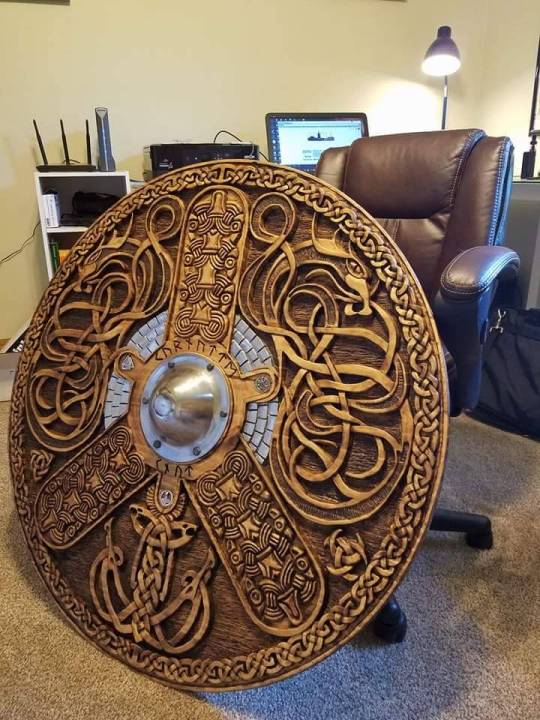
However, more critical – and astounding for the individuals who perspective of the Vikings is as one-dimensional warriors – is the accumulation of adventures known as the Íslendingasögur or Icelandic Family Sagas. Their setting is the initial 150 long periods of the Viking state in Iceland and they recount regularly vexed relations between the fundamental Icelandic families. Unions, treacheries, quarrels and murders play out against the setting of a scene in which highlights can at present regularly be distinguished today. Getting it done, in stories, for example, Njál's Saga or Egil's Saga, they are ground-breaking bits of writing in their own particular right, and among the most imperative written work to make due from any European nation in the Middle Ages.
0 notes